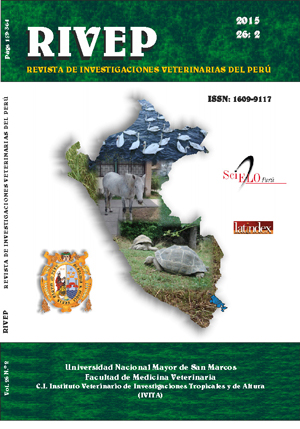Effect of chemical disinfectants and plant extracts on bacterial load in carcasses of guinea pigs (Cavia porcellus)
DOI:
https://doi.org/10.15381/rivep.v26i2.11013Keywords:
guinea pig, carcasse, chlorine dioxide, disinfectionAbstract
The aim of the study was to evaluate the effectiveness of chlorine dioxide (CD), eucalyptus leaf extract - grapefruit seed (ELE-GS), seed extract - grapefruit pulp (SE-GP) on reducing the load of aerobic mesophilic bacteria, E. coli, and total coliforms in guinea pig carcasses (Cavia porcellus). It was used a completely randomized factorial design with seven treatments: T1 = Control, T2 = CD 20 ppm, T3 = CD 30 ppm, T4 = ELE-GS 3000 ppm, T5 = ELE-GS 5000 ppm, T6 = SE-GP 400 ppm and T7 = SE-GP 800 ppm, where each treatment had five replicates (carcasses), except T1 (n=6). All treatments were effective in reducing the load of aerobic mesophilic bacteria in relation to the control group (T1). In the case ofE. coli, T5 was more efficient than T1 (p<0.05), and in total coliforms, T3, T5, T6, and T7 were more efficient that T1 (p<0.05). It is concluded that the use of CD 30 ppm and ELE-GS 5000 ppm significantly reduce the bacterial load in carcasses of guinea pigs.Downloads
Downloads
Published
Issue
Section
License
Copyright (c) 2015 Raúl Sánchez V., Marcial Silva J., Ronald Jiménez A., Otto Zea M.

This work is licensed under a Creative Commons Attribution-NonCommercial-ShareAlike 4.0 International License.
AUTHORS RETAIN THEIR RIGHTS:
a. Authors retain their trade mark rights and patent, and also on any process or procedure described in the article.
b. Authors retain their right to share, copy, distribute, perform and publicly communicate their article (eg, to place their article in an institutional repository or publish it in a book), with an acknowledgment of its initial publication in the Revista de Investigaciones Veterinarias del Perú (RIVEP).
c. Authors retain theirs right to make a subsequent publication of their work, to use the article or any part thereof (eg a compilation of his papers, lecture notes, thesis, or a book), always indicating the source of publication (the originator of the work, journal, volume, number and date).



